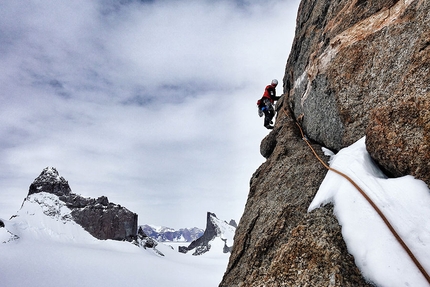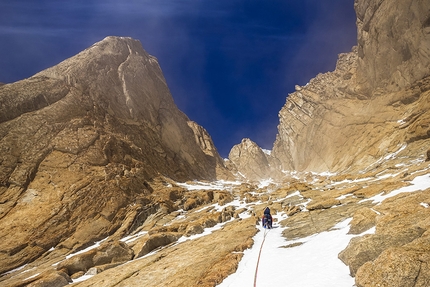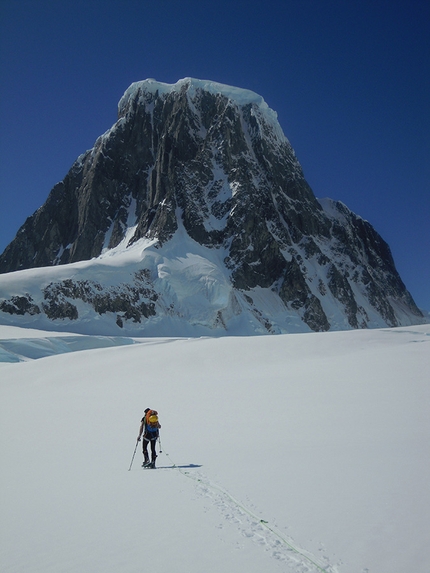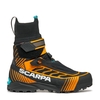Antarctica: beyond the end of the world with Gianluca Cavalli, Manrico Dell'Agnola, Marcello Sanguineti

 1 / 6
1 / 6 Manrico Dell'Agnola
Manrico Dell'Agnola
On board the tiny Ice Bird, after navigating through a wild kingdom of wild seas and spectacular icebergs, the Italian alpinists Gianluca Cavalli, Manrico Dell'Agnola e Marcello Sanguineti explored one of the last untouched places on earth, the Antarctic. Their journey is documented in a three-part Karpos web series and in this first one they depart from "Fin del Mundo", the end the world at Ushuaia on the southernmost tip of Patagonia, and cross the Drake Passage on their quest for exploration.
ANTARCTICA DIARY: BEYOND THE END OF THE WORLD! by Manrico Dell’Agnola
January 1, 1 p.m. We leave the port of Ushuaia. The sea is calm, and a warm sun puts us in a cheerful mood. Slowly and without incident we drag ourselves up to Port Williams, along endless coasts of lenga beech and numerous flocks of birds. At the port, a girl with an old rubber dinghy takes us ashore. Everything should be resolved in a short time, but the Chilean Carabineros keep us moored at the small port. A major storm is approaching, and various bureaucratic complications, which in Chile we discover to be normal, prevent us from leaving. Ice Bird is the name of our “walnut shell,” a sailboat of about 20 meters. The name refers to the small boat that David Lewis used to make the first solo (almost) circumnavigation of Antarctica. There are nine of us in it: our young captain, Oly; his assistant, Dave; the mountain guide Phil with his clients; and the three of us, the only Italians.
January 2. After endless hours we set sail. The sea is calm, and the warm colors of the sunset make me feel good. One of our travel companions flies a drone over the boat: from the outside we are beautiful, a long strip of sparkling light passes through us. Everything goes smoothly, and we drop anchor near Lennox Island, just west of Cape Horn, the terror of navigators. Tomorrow we will no longer be able to rely on the protection of the islands; we will have to go out into the open, crossing the Drake Passage, where the two great oceans, the Pacific and the Atlantic, meet. Stories of this crossing send a shiver down my spine, but it’s better not to think about it.
January 4. Today is my daughter Valentina’s birthday. Yesterday was terrible. Huge long waves tormented us, and sailing doesn’t help. I threw up all day and I hurt everywhere. It’s 3 p.m. and I’m feeling a little better, but my stomach is still upset. Fortunately, we’re almost halfway through the passage. Cleaning the boat, then going to bed for a while. Sleep is liberating.
January 6. We see the first small Antarctic islands through the fog. Outside it’s 1° Celsius and the coast, still very far away, appears white. Everything out there seems white, cold, and motionless. Thinking about pitching a tent there makes me shiver. We’ve gotten ourselves in trouble!
4 p.m. The day goes on forever. We’ve seen huge icebergs and countless whales. Now we’re sailing along a long and vertiginous frozen coast, still far away. The fog gives the environment a surreal, harsh, and inhospitable air. The sea is calm and it’s comfortable on the boat now. We slowly advance among these huge blocks of ice. We seem to be suspended in nothingness, but we feel like we’ve reached our first goal. Climbing those icebergs would be a good and easy opportunity to get some nice shots, but our captain absolutely forbids it. He tells us that if one of those ice blocks were to flip over, we could all be dead. It doesn’t matter, because our objective is different: we want to climb rock walls — rock that we discover to be very bad, though, ground by the millennial work of the glaciers and at this moment made extremely dangerous by sudden melting.
Link: www.karpos-outdoor.com



 Copia link
Copia link





 See all photos
See all photos



























